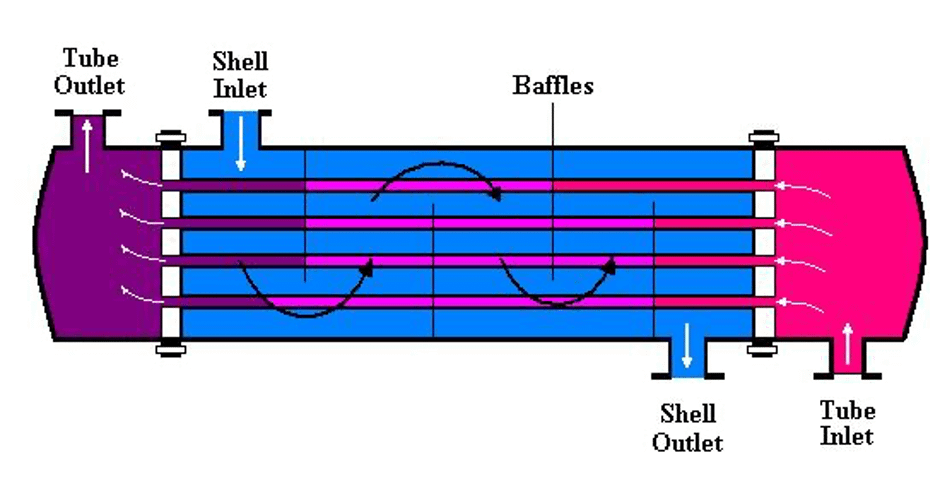The Heat Exchanger Theory article provides you with an introduction to the fundamentals of a heat exchanger and will be useful to understand the concept of heat exchanger inspection.
To describe this Theory, you may know we need to heat or to cool process fluids in industrial plants to facilitate process reactions.So we need to use heat exchangers either to reduce the temperature or increase the temperature.
Speaking of Heat Exchangers, specialised boiler tubes are utilised in proper functioning of such exchangers. SA179tube.com Is one leading Manufacturer, Supplier & Stockist Of A519 Mechanical Tubing.
In most heat exchangers, two fluids are exchanging their heat without direct physical contact to avoid mixing. This is called indirect heat transfer.
Cooling water temperature in a hot area is normally above 25 degrees centigrade, and it depends on the atmospheric and climate conditions. To reach the range of 1 to 5 degrees centigrade, we need to use chilled water, which is already cooled by a refrigerant.
To reach the sub-zero temperature, we need to use refrigerant fluid alone, such as R-11 or propylene.For heating purposes, the mechanism is similar to cooling. We can use hot intermediate fluid such as hot water or steam and even other hot process streams.
To proceed on the heat exchanger theory we need to know that the meaning of the following terminologies:

Sensible Heat
Sensible heat is the amount of heat that a material can exchange without changing its phase. For example, water at 25 degrees centigrade enters the heat exchanger and absorbs the process fluid heat and exits from the heat exchanger at 35 degrees centigrade.
What is latent Heat?
The latent heat is the amount of heat transfer that a material exchanges during the change from the liquid phase to the vapor phase.
Referring to the above definition we are using saturated steam in heat exchangers, the saturated steam is converted to liquid and the released heat will heat our process fluid.
Indirect heat transfers are done in different heat exchangers such as coolers, heaters, reboilers and condensers.
We are calling it indirect because the two fluids during the heat transfer process are not mixing together; the heat transfer is done through a metallic surface.
In the above, the heat exchanger that we are using to eliminate latent heat is called a condenser and the one that is used to supply steam and heat to the distillation tower is called a reboiler. We will discuss them in detail in the coming paragraphs.
In all of them, we are using an intermediate fluid for heat transfer. For the condenser, it is cooling water, and in the reboiler, it is steam.
For cooler heat exchanger cooling water, refrigerants such as R-11, Propylene and propane are used.
For heater heat exchangers, steam with different pressures are used. In heat exchanger theory for reducing energy consumption, sometimes process fluids are used for heat transfer themselves.
For example, the outlet of a reactor needs to be cooled at the same time the inlet of the reactor feed needs to be heated. So in this case, a heat exchanger can be designed to transfer the heats between the two process streams and save energy consumption.
In the above example, steam will not be used for reactor feed, and cooling water will not be used for reactor products. Energy will be saved.
The heat exchanger that we use to remove latent heat is called a condenser, and the one that we use to supply steam and heat to the distillation tower is called a reboiler. In the following paragraphs, we will discuss them in more detail.In all of them, heat is transferred via an intermediate fluid. The condenser uses cooling water, while the reboiler uses steam.
Refrigerants such as R-11, Propylene, and propane are used for cooler heat exchanger cooling water.Heat exchangers for heaters use steam under various pressures. Process fluids are sometimes used for heat transfer in heat exchanger theory to reduce energy consumption.
The outlet of a reactor, for example, must be cooled while the inlet of the reactor feed must be heated. In this case, a heat exchanger can be designed to transfer heat between the two process streams and reduce the energy consumption.
In the above example, steam will not be used for reactor feed, and cooling water will not be used for reactor products. Energy will be saved.
The heat exchangers are built in a way so that cold and hot fluid is separated by a metallic surface to avoid mixing.
These metallic surfaces are different in different heat exchanger types.The metallic surface in a shell and tube and an air-cooled heat exchanger is a tube wall, and in the plate heat exchanger, it is a thin wall plate, in which each process fluid is on a different side.
The heat transfer inside of process fluids is done by the convection mechanism, and on the metallic surface, it is done by the conduction mechanism.
SA179tubes.com is a leading supplier, stockist, manufacturer & exporter of A519 Mechanical Tubing. Get in touch with us for the best rates & availability.
